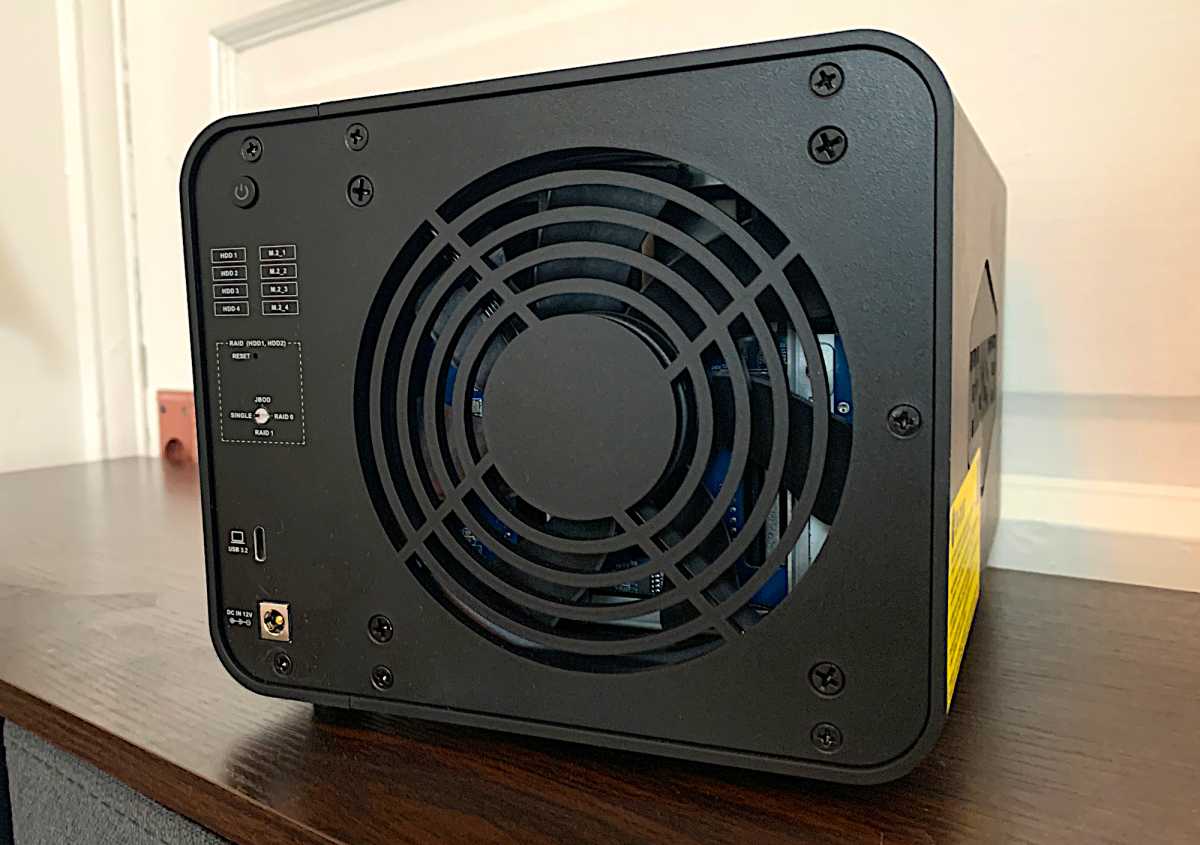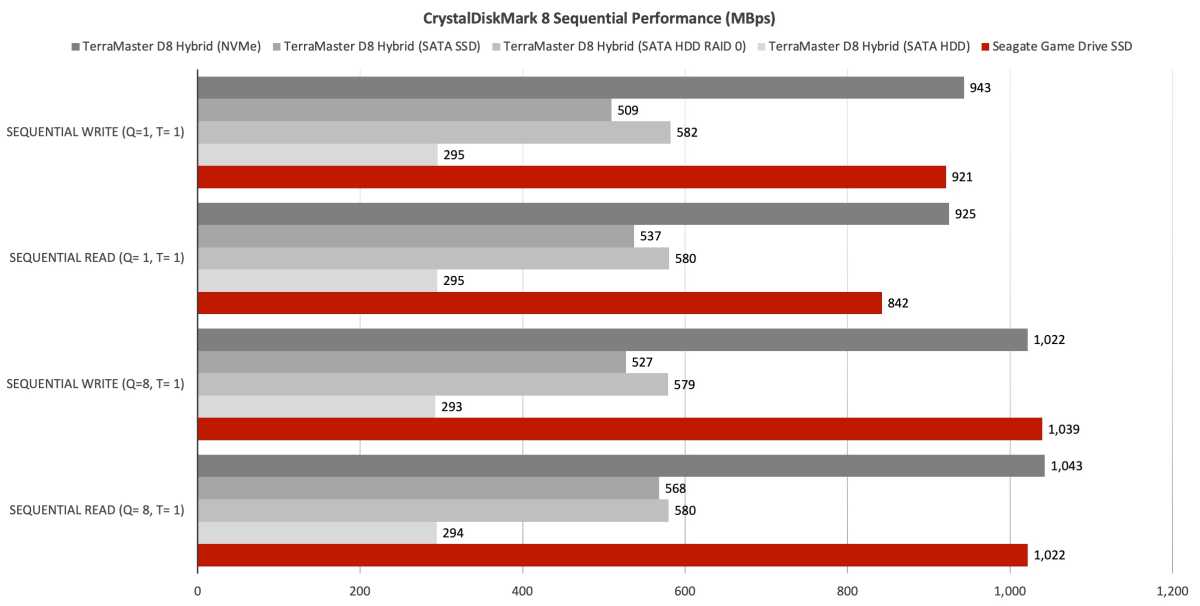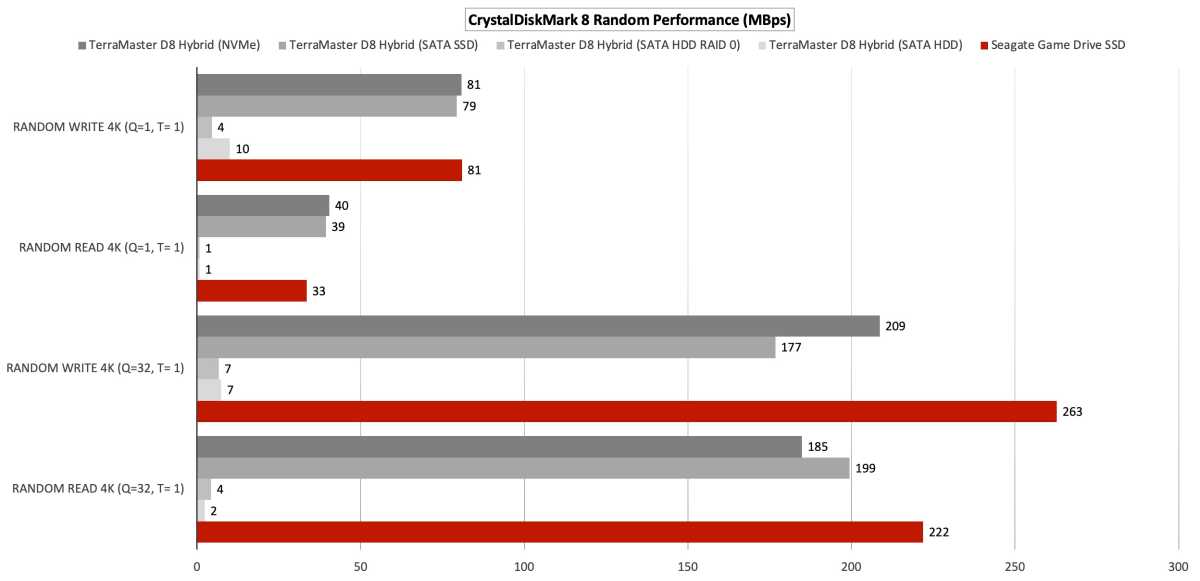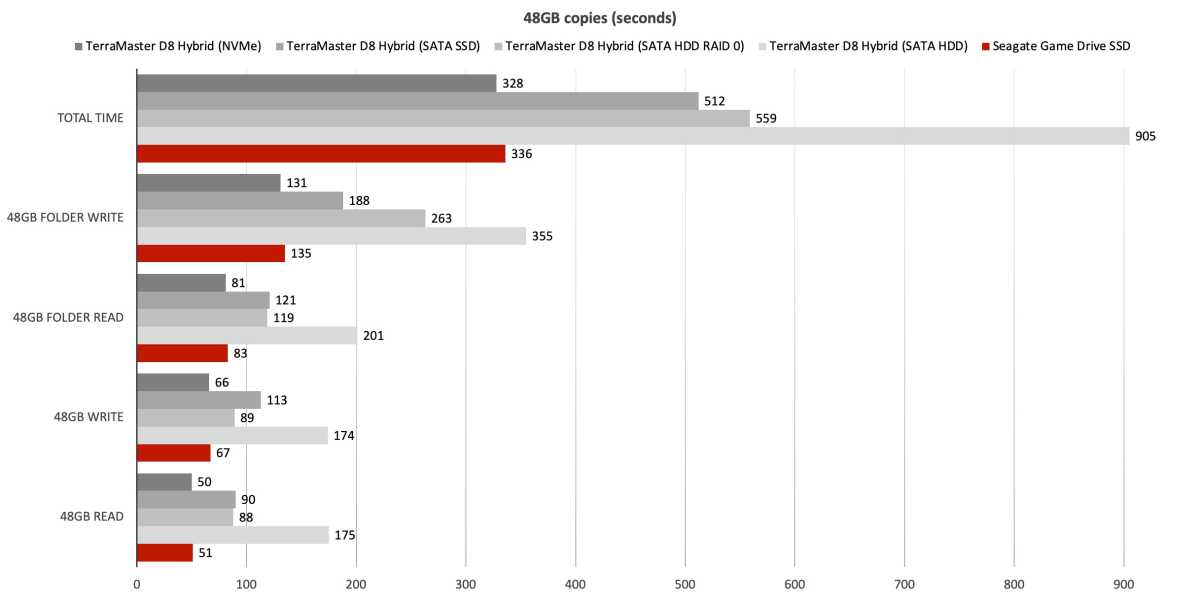- Регистрация
- 17 Февраль 2018
- Сообщения
- 25 396
- Лучшие ответы
- 0
- Баллы
- 2 093
Offline
At a glance
Expert's Rating
Pros
The D8 Hybrid is a versatile USB storage enclosure that lets you use up to four 3.5/2.5-inch HDDs or SSDs, as well as up to four NVMe SSDs. It’s only 10Gbps, which is easily fast enough for HDDs and SATA SSDs, but limiting for the NVMe SSDs.
Price When Reviewed
This value will show the geolocated pricing text for product undefined
Best Pricing Today
Best Prices Today: TerraMaster D8 Hybrid HDD/SSD USB enclosure
Retailer
Price
TerraMaster
$299.99
View Deal
Price comparison from over 24,000 stores worldwide
Product
Price
Price comparison from Backmarket
With four full-sized 3.5/2.5-inch SATA bays, and four 2280 M.2 slots to accept NVMe SSDs, the D8 Hybrid is an incredibly versatile external storage enclosure capable of housing up to 162TB of storage (30TB HDDs/8TB SSDs). It’s also a good performer within the limits of 10Gbps USB.
What are the D8 Hybrid’s features?
I already enumerated the available storage bays/slots for you above, but you can also use 2.5-inch SATA SSDs or 2.5-inch HDDs in the 3.5-inch drive bays. SATA SSDs will deliver faster performance individually or combined in RAID 0, but 2.5-inch HDDs lag far behind their larger cousins in both capacity and speed.
The D8 Hybrid is a largely black plastic box measuring 8.75-inches deep, by 6.75-inches tall, by 7-inches wide (approximate measurements), encasing a metal frame. The four 3.5-inch drive trays are easy open, but don’t lock. Two screws on the back of the enclosure secure the removable side panel that hides the four M.2 NVMe slots.

The D8 Hybrid’s M.2 slots filled with various NVMe SSDs.
A minor issue with the M.2 slots is shown above: I was able to screw down an NVMe SSD while it wasn’t completely inserted into the M.2 socket, and then it didn’t appear when the box powered on. Make sure you don’t see any SSD metal edge contacts when you install them.
While the D8 Hybrid supports RAID, it applies to only the first two 3.5-inch drive bays. Drives in the six other bay/slots appear as single LUNs (logical units)/drives. Consider the D8 a two-drive RAID box with two extra bays and four M.2 slots. We’re not pooh-poohing the arrangement. It can be very handy under the right circumstances — that being lots of miscellaneous SATA and NVMe storage laying about.

The rear of the D8 Hybrid with a Type-C port, power port, RAID mode selector, and RAID reset pinhole button.
The back of the D8 Hyrbid is home to the RAID select rotary switch (single, JBOD/concatenated, striped RAID 0, and mirrored RAID 1), a RAID reset pinhole button, a large fan opening, a power jack, and the on/off button.
As discussed, USB 3.2 10Gbps is the transport interface, and TerraMaster includes a high-quality Type-C to Type-C cable with the unit. The AC adapter is a 7.5 amp/12-volt type with a detachable wall cord.
How much is the TerraMaster D8 Hybrid?
The D8 Hybrid was $300 at the time of this writing, or little less than $40 a bay. That’s certainly less than what you’d pay for a 10Gbps dual 3.5-inch RAID enclosure plus six other enclosures.
And there is value in consolidating all those drives into one box and onto one connection. Especially given the often parsimonious port allotment on today’s thin and light laptops! In other words, if the D8 Hybrid fits your needs, it’s a pretty good deal.
How fast is the D8 Hybrid?
The speed that the D8 Hybrid delivers will depend highly upon what type of storage you install. But whatever it is, it will max out at around 1GBps due to the 10Gbps bus. I’m a tad surprised that TerraMaster didn’t go for USB 3.2×2 or USB 4. I’ve been chagrined at other NVMe-enabled products making similar choices recently — the scuttlebutt is that chips for USB 4 are still in short supply.
Just to be clear as to the relevant conundrum: NVMe is capable of 3GBps plus when used over Thunderbolt 3/4 or USB 4, and 2GBps over 20Gbps USB 3.2×2.
Bus choice aside, the D8 Hybrid performed up to 10Gbps snuff, which is pretty darn fast in the real world. I saw just over 1GBps out of SSDs in the NVMe slots, 570MBps out of SATA SSDs in the 3.5-inch bays, 290MBps from a single 3.5-inch, 24GB WD DC HC580 hard drive, and 580MBps from two of the latter in RAID 0. That is very good on all accounts for USB 10Gbps.
While the D8 Hybrid only offers RAID for the first two bays, you can use Windows (or macOS) software RAID to create more complex arrays…
Note that instead of highlighting the drive being reviewed in red, this time it’s gray, with the Seagate Game Drive SSD — another 10Gbps product that is a good match for the D8 Hybrid’s NVMe slots — in red to highlight the 10Gbps cap. Why? I didn’t like the other shades of red I came up with. Sue me.
The D8 Hybrid actually beat the Seagate Game SSD drive with NVMe. But the Sabrent Rocket 4 I used may be a faster SSD than the one inside the Seagate. Regardless, you know you’re not sacrificing performance for the D8 Hybrid’s versatility. Given the 10Gbps constraint, at any rate.

CrystalDiskMark 8 rated the D8 Hybrid as completely up to snuff for a 10Gbps USB enclosure. Longer bars are better.
You can basically disregard the HDD numbers in the CrystalDiskMark 8 4K tests. Hard drives simply don’t access data with anywhere near the alacrity of an SSD of any type.

You can basically disregard the HDD numbers in the CrystalDiskMark 8 4K tests. Hard drives simply don’t access data with anywhere near the alacrity of an SSD of any type. Longer bars are better.
Remember that shorter bars are better in the graph below charting 48GB transfer performance, where the D8 Hybrid did quite well in all phases — for the type of media involved, of course.

Remember that shorter bars are better in this graph charting 48GB transfer performance, where the D8 Hybrid did very well. Shorter bars are better.
The D8 Hybrid was right on target with the various media types for the 450GB long file write.

The D8 Hybrid was right on target with the various media types for the 450GB long file write. Shorter bars are better.
Other than wishing it was 20Gbps or 40Gbps technology, I have zero complaints about the D8 Hybrid’s performance. And you can get a lot done with 1GBps transfers.
While the D8 Hybrid only offers RAID for the first two bays, you can use Windows (or macOS) software RAID to create more complex arrays or utilize more of the D8 Hybrid’s eight drives in that fashion. I’d only recommend it for redundancy (mirroring, RAID 5) as the 10Gbps USB bus is going to cap performance at 1GBps no matter how you combine the SSDs.
Should you buy the D8 Hybrid?
If you’re looking to run a pair of hard drives in RAID 0, plus a couple of other HDDs/SATA SSDs, as well as some NVMe SSDs externally, then the TerraMaster D8 Hybrid is a versatile way to combine them all into one physical box. Performance is certainly good enough for most tasks, albeit limiting for NVMe.
Put another way, if price, capacity, versatility, and HDD/SSD SATA support are paramount, the D8 Hybrid is a great product — an excellent way to employ miscellaneous drives you may have lying about. But if you’re looking for top-tier performance from your NVMe SSDs, look to something utilizing a faster bus.
Expert's Rating
Pros
- Eight bays/slots for HDDs and SSDs
- Supports SATA and NVMe
- Runs two HDDs in RAID
- Affordable for the ilk
- 10Gbps caps NVMe performance at 1GBps
- No RAID for the last two HDD bays
The D8 Hybrid is a versatile USB storage enclosure that lets you use up to four 3.5/2.5-inch HDDs or SSDs, as well as up to four NVMe SSDs. It’s only 10Gbps, which is easily fast enough for HDDs and SATA SSDs, but limiting for the NVMe SSDs.
Price When Reviewed
This value will show the geolocated pricing text for product undefined
Best Pricing Today
Best Prices Today: TerraMaster D8 Hybrid HDD/SSD USB enclosure
Retailer
Price
TerraMaster
$299.99
View Deal
Price comparison from over 24,000 stores worldwide
Product
Price
Price comparison from Backmarket
With four full-sized 3.5/2.5-inch SATA bays, and four 2280 M.2 slots to accept NVMe SSDs, the D8 Hybrid is an incredibly versatile external storage enclosure capable of housing up to 162TB of storage (30TB HDDs/8TB SSDs). It’s also a good performer within the limits of 10Gbps USB.
What are the D8 Hybrid’s features?
I already enumerated the available storage bays/slots for you above, but you can also use 2.5-inch SATA SSDs or 2.5-inch HDDs in the 3.5-inch drive bays. SATA SSDs will deliver faster performance individually or combined in RAID 0, but 2.5-inch HDDs lag far behind their larger cousins in both capacity and speed.
The D8 Hybrid is a largely black plastic box measuring 8.75-inches deep, by 6.75-inches tall, by 7-inches wide (approximate measurements), encasing a metal frame. The four 3.5-inch drive trays are easy open, but don’t lock. Two screws on the back of the enclosure secure the removable side panel that hides the four M.2 NVMe slots.

The D8 Hybrid’s M.2 slots filled with various NVMe SSDs.
A minor issue with the M.2 slots is shown above: I was able to screw down an NVMe SSD while it wasn’t completely inserted into the M.2 socket, and then it didn’t appear when the box powered on. Make sure you don’t see any SSD metal edge contacts when you install them.
While the D8 Hybrid supports RAID, it applies to only the first two 3.5-inch drive bays. Drives in the six other bay/slots appear as single LUNs (logical units)/drives. Consider the D8 a two-drive RAID box with two extra bays and four M.2 slots. We’re not pooh-poohing the arrangement. It can be very handy under the right circumstances — that being lots of miscellaneous SATA and NVMe storage laying about.

The rear of the D8 Hybrid with a Type-C port, power port, RAID mode selector, and RAID reset pinhole button.
The back of the D8 Hyrbid is home to the RAID select rotary switch (single, JBOD/concatenated, striped RAID 0, and mirrored RAID 1), a RAID reset pinhole button, a large fan opening, a power jack, and the on/off button.
As discussed, USB 3.2 10Gbps is the transport interface, and TerraMaster includes a high-quality Type-C to Type-C cable with the unit. The AC adapter is a 7.5 amp/12-volt type with a detachable wall cord.
How much is the TerraMaster D8 Hybrid?
The D8 Hybrid was $300 at the time of this writing, or little less than $40 a bay. That’s certainly less than what you’d pay for a 10Gbps dual 3.5-inch RAID enclosure plus six other enclosures.
And there is value in consolidating all those drives into one box and onto one connection. Especially given the often parsimonious port allotment on today’s thin and light laptops! In other words, if the D8 Hybrid fits your needs, it’s a pretty good deal.
How fast is the D8 Hybrid?
The speed that the D8 Hybrid delivers will depend highly upon what type of storage you install. But whatever it is, it will max out at around 1GBps due to the 10Gbps bus. I’m a tad surprised that TerraMaster didn’t go for USB 3.2×2 or USB 4. I’ve been chagrined at other NVMe-enabled products making similar choices recently — the scuttlebutt is that chips for USB 4 are still in short supply.
Just to be clear as to the relevant conundrum: NVMe is capable of 3GBps plus when used over Thunderbolt 3/4 or USB 4, and 2GBps over 20Gbps USB 3.2×2.
Bus choice aside, the D8 Hybrid performed up to 10Gbps snuff, which is pretty darn fast in the real world. I saw just over 1GBps out of SSDs in the NVMe slots, 570MBps out of SATA SSDs in the 3.5-inch bays, 290MBps from a single 3.5-inch, 24GB WD DC HC580 hard drive, and 580MBps from two of the latter in RAID 0. That is very good on all accounts for USB 10Gbps.
While the D8 Hybrid only offers RAID for the first two bays, you can use Windows (or macOS) software RAID to create more complex arrays…
Note that instead of highlighting the drive being reviewed in red, this time it’s gray, with the Seagate Game Drive SSD — another 10Gbps product that is a good match for the D8 Hybrid’s NVMe slots — in red to highlight the 10Gbps cap. Why? I didn’t like the other shades of red I came up with. Sue me.
The D8 Hybrid actually beat the Seagate Game SSD drive with NVMe. But the Sabrent Rocket 4 I used may be a faster SSD than the one inside the Seagate. Regardless, you know you’re not sacrificing performance for the D8 Hybrid’s versatility. Given the 10Gbps constraint, at any rate.

CrystalDiskMark 8 rated the D8 Hybrid as completely up to snuff for a 10Gbps USB enclosure. Longer bars are better.
You can basically disregard the HDD numbers in the CrystalDiskMark 8 4K tests. Hard drives simply don’t access data with anywhere near the alacrity of an SSD of any type.

You can basically disregard the HDD numbers in the CrystalDiskMark 8 4K tests. Hard drives simply don’t access data with anywhere near the alacrity of an SSD of any type. Longer bars are better.
Remember that shorter bars are better in the graph below charting 48GB transfer performance, where the D8 Hybrid did quite well in all phases — for the type of media involved, of course.

Remember that shorter bars are better in this graph charting 48GB transfer performance, where the D8 Hybrid did very well. Shorter bars are better.
The D8 Hybrid was right on target with the various media types for the 450GB long file write.

The D8 Hybrid was right on target with the various media types for the 450GB long file write. Shorter bars are better.
Other than wishing it was 20Gbps or 40Gbps technology, I have zero complaints about the D8 Hybrid’s performance. And you can get a lot done with 1GBps transfers.
While the D8 Hybrid only offers RAID for the first two bays, you can use Windows (or macOS) software RAID to create more complex arrays or utilize more of the D8 Hybrid’s eight drives in that fashion. I’d only recommend it for redundancy (mirroring, RAID 5) as the 10Gbps USB bus is going to cap performance at 1GBps no matter how you combine the SSDs.
Should you buy the D8 Hybrid?
If you’re looking to run a pair of hard drives in RAID 0, plus a couple of other HDDs/SATA SSDs, as well as some NVMe SSDs externally, then the TerraMaster D8 Hybrid is a versatile way to combine them all into one physical box. Performance is certainly good enough for most tasks, albeit limiting for NVMe.
Put another way, if price, capacity, versatility, and HDD/SSD SATA support are paramount, the D8 Hybrid is a great product — an excellent way to employ miscellaneous drives you may have lying about. But if you’re looking for top-tier performance from your NVMe SSDs, look to something utilizing a faster bus.
